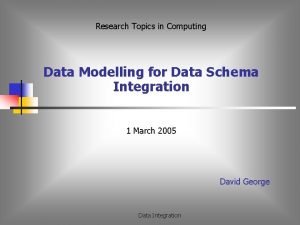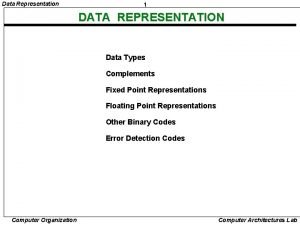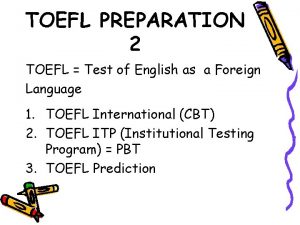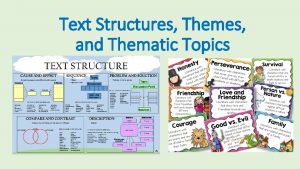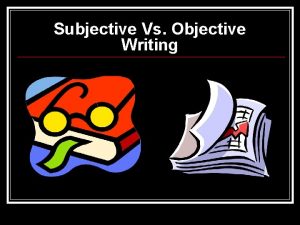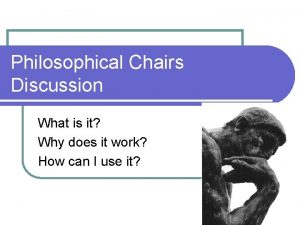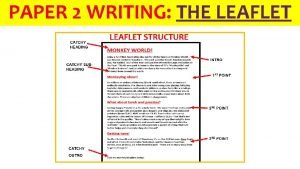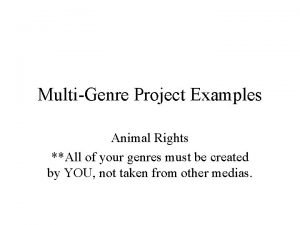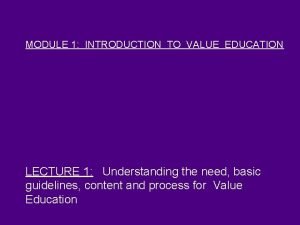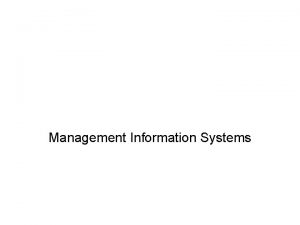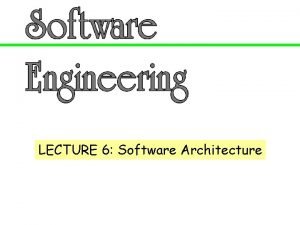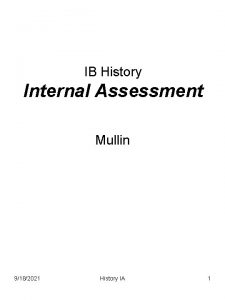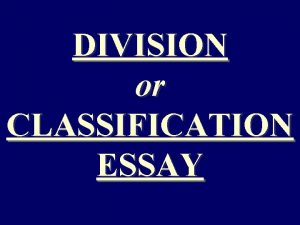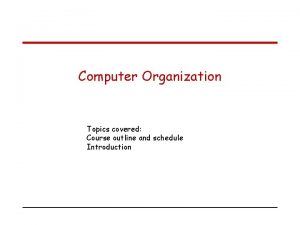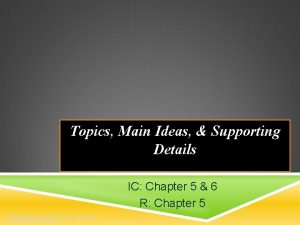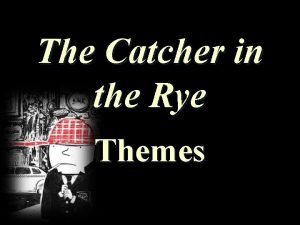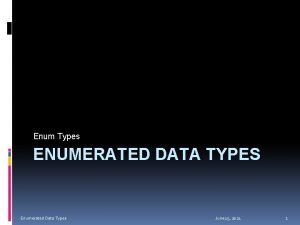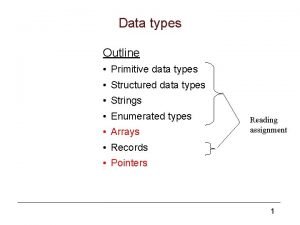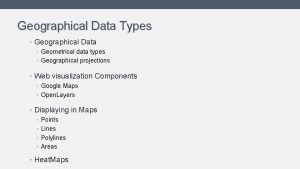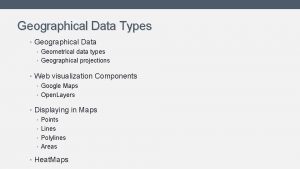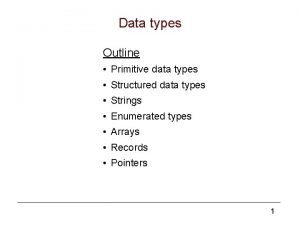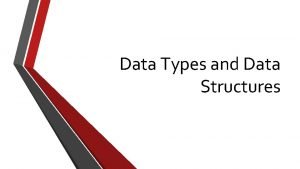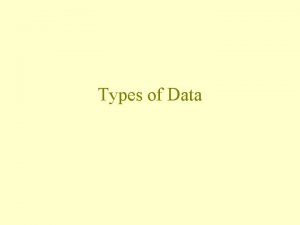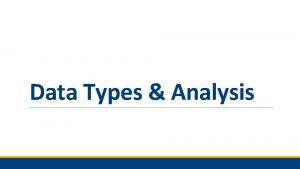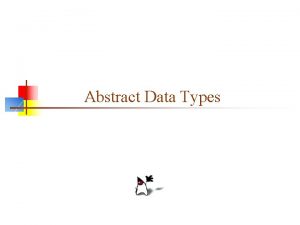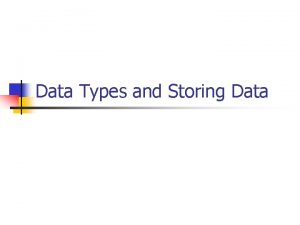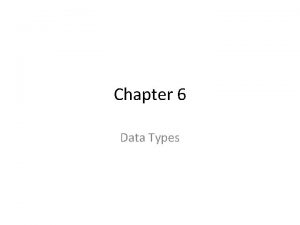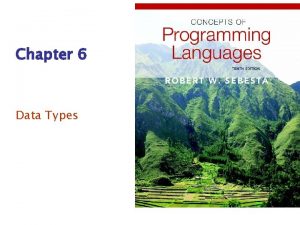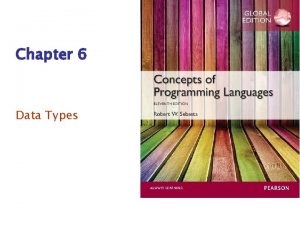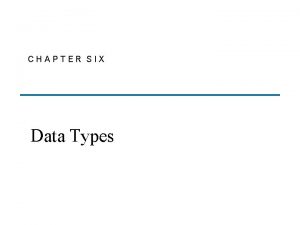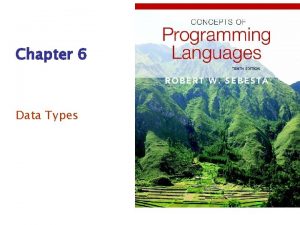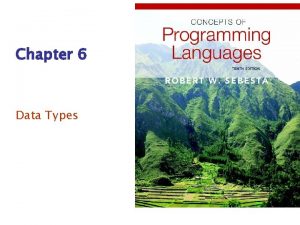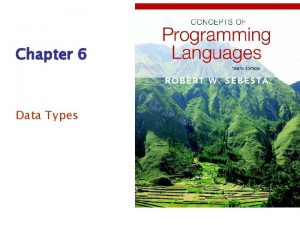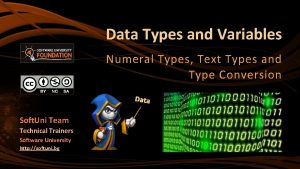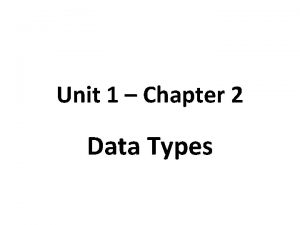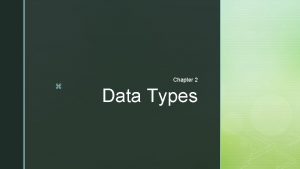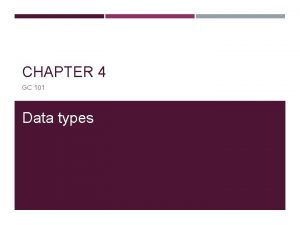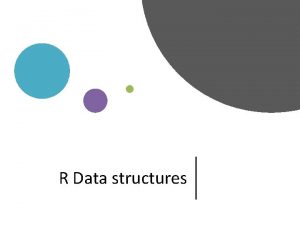CHAPTER 6 Data Types CHAPTER 6 TOPICS Introduction






































![LOCATING AN ELEMENT IN A MULTIDIMENSIONED ARRAY • General format location (a[i, j]) = LOCATING AN ELEMENT IN A MULTIDIMENSIONED ARRAY • General format location (a[i, j]) =](https://slidetodoc.com/presentation_image_h2/bdd9c2ecc715f70c1edee7f4d9710fe4/image-39.jpg)

























![POINTER ARITHMETIC IN C AND C++ float stuff[100]; float *p; p = stuff; // POINTER ARITHMETIC IN C AND C++ float stuff[100]; float *p; p = stuff; //](https://slidetodoc.com/presentation_image_h2/bdd9c2ecc715f70c1edee7f4d9710fe4/image-65.jpg)



















- Slides: 84

CHAPTER 6 Data Types

CHAPTER 6 TOPICS Introduction Primitive Data Types Character String Types User-Defined Ordinal Types Array Types Associative Arrays Record Types Union Types Pointer and Reference Types 1 -2 CCSB 314 Programming Language

INTRODUCTION A data type defines a collection of data objects and a set of predefined operations on those objects A descriptor is the collection of the attributes of a variable An object represents an instance of a user-defined (abstract data) type One design issue for all data types: What operations are defined and how are they specified? 1 -3 CCSB 314 Programming Language

PRIMITIVE DATA TYPES Almost all programming languages provide a set of primitive data types Primitive data types: Those not defined in terms of other data types Some primitive data types are merely reflections of the hardware Others require little non-hardware support 1 -4 CCSB 314 Programming Language

PRIMITIVE DATA TYPES: INTEGER Almost always an exact reflection of the hardware so the mapping is trivial There may be as many as eight different integer types in a language Java’s signed integer sizes: byte, short, int, long 1 -5 CCSB 314 Programming Language

PRIMITIVE DATA TYPES: FLOATING POINT Model real numbers, but only as approximations Languages for scientific use support at least two floating-point types (e. g. , float and double; sometimes more Usually exactly like the hardware, but not always IEEE Floating-Point Standard 754 1 -6 CCSB 314 Programming Language

PRIMITIVE DATA TYPES: DECIMAL For business applications (money) Essential to COBOL C# offers a decimal data type Store a fixed number of decimal digits Advantage: accuracy Disadvantages: limited range, wastes memory 1 -7 CCSB 314 Programming Language

PRIMITIVE DATA TYPES: BOOLEAN Simplest of all Range of values: two elements, one for “true” and one for “false” Could be implemented as bits, but often as bytes Advantage: readability 1 -8 CCSB 314 Programming Language

PRIMITIVE DATA TYPES: CHARACTER Stored as numeric codings Most commonly used coding: ASCII An alternative, 16 -bit coding: Unicode Includes characters from most natural languages Originally used in Java C# and Java. Script also support Unicode 1 -9 CCSB 314 Programming Language

CHARACTER STRING TYPES Values are sequences of characters Design issues: Is it a primitive type or just a special kind of array? Should the length of strings be static or dynamic? 1 -10 CCSB 314 Programming Language

CHARACTER STRING TYPES OPERATIONS Typical operations: Assignment and copying Comparison (=, >, etc. ) Catenation Substring reference Pattern matching 1 -11 CCSB 314 Programming Language

CHARACTER STRING TYPE IN CERTAIN LANGUAGES C and C++ Not primitive Use char arrays and a library of functions that provide operations SNOBOL 4 (a string manipulation language) Primitive Many operations, including elaborate pattern matching Java Primitive via the String class 1 -12 CCSB 314 Programming Language

CHARACTER STRING LENGTH OPTIONS Static: COBOL, Java’s String class Limited Dynamic Length: C and C++ In C-based language, a special character is used to indicate the end of a string’s characters, rather than maintaining the length Dynamic (no maximum): SNOBOL 4, Perl, Java. Script Ada supports all three string length options 1 -13 CCSB 314 Programming Language

CHARACTER STRING TYPE EVALUATION Aid to writability As a primitive type with static length, they are inexpensive to provide--why not have them? Dynamic length is nice, but is it worth the expense? 1 -14 CCSB 314 Programming Language

CHARACTER STRING IMPLEMENTATION Static length: compile-time descriptor Limited dynamic length: may need a run-time descriptor for length (but not in C and C++) Dynamic length: need run-time descriptor; allocation/deallocation is the biggest implementation problem 1 -15 CCSB 314 Programming Language

COMPILE- AND RUN-TIME DESCRIPTORS Compile-time descriptor for static strings CCSB 314 Programming Language Run-time descriptor for limited dynamic strings 1 -16

USER-DEFINED ORDINAL TYPES An ordinal type is one in which the range of possible values can be easily associated with the set of positive integers Examples of primitive ordinal types in Java integer char boolean 1 -17 CCSB 314 Programming Language

ENUMERATION TYPES All possible values, which are named constants, are provided in the definition C# example enum days {mon, tue, wed, thu, fri, sat, sun}; Design issues Is an enumeration constant allowed to appear in more than one type definition, and if so, how is the type of an occurrence of that constant checked? Are enumeration values coerced to integer? Any other type coerced to an enumeration type? 1 -18 CCSB 314 Programming Language

EVALUATION OF ENUMERATED TYPE Aid to readability, e. g. , no need to code a color as a number Aid to reliability, e. g. , compiler can check: operations (don’t allow colors to be added) No enumeration variable can be assigned a value outside its defined range Ada, C#, and Java 5. 0 provide better support for enumeration than C++ because enumeration type variables in these languages are not coerced into integer types 1 -19 CCSB 314 Programming Language

SUBRANGE TYPES An ordered contiguous subsequence of an ordinal type Example: 12. . 18 is a subrange of integer type Ada’s design type Days is (mon, tue, wed, thu, fri, sat, sun); subtype Weekdays is Days range mon. . fri; subtype Index is Integer range 1. . 100; Day 1: Days; Day 2: Weekday; Day 2 : = Day 1; 1 -20 CCSB 314 Programming Language

SUBRANGE EVALUATION Aid to readability Make it clear to the readers that variables of subrange can store only certain range of values Reliability Assigning a value to a subrange variable that is outside the specified range is detected as an error 1 -21 CCSB 314 Programming Language

IMPLEMENTATION OF USERDEFINED ORDINAL TYPES Enumeration types are implemented as integers Subrange types are implemented like the parent types with code inserted (by the compiler) to restrict assignments to subrange variables 1 -22 CCSB 314 Programming Language

ARRAY TYPES An array is an aggregate of homogeneous data elements in which an individual element is identified by its position in the aggregate, relative to the first element. 1 -23 CCSB 314 Programming Language

ARRAY DESIGN ISSUES What types are legal for subscripts? Are subscripting expressions in element references range checked? When are subscript ranges bound? When does allocation take place? What is the maximum number of subscripts? Can array objects be initialized? Are any kind of slices allowed? 1 -24 CCSB 314 Programming Language

ARRAY INDEXING Indexing (or subscripting) is a mapping from indices to elements array_name (index_value_list) an element Array reference : array name followed by list of subscripts which surrounded by brackets or parentheses. Index Syntax FORTRAN, PL/I, Ada use parentheses Ada explicitly uses parentheses to show uniformity between array references and function calls because both are mappings Most other languages use brackets 1 -25 CCSB 314 Programming Language

ARRAYS INDEX (SUBSCRIPT) TYPES FORTRAN, C: integer only Pascal: any ordinal type (integer, Boolean, char, enumeration) Ada: integer or enumeration (includes Boolean and char) Java: integer types only C, C++, Perl, and Fortran do not specify range checking Java, ML, C# specify range checking 1 -26 CCSB 314 Programming Language

SUBSCRIPT BINDING AND ARRAY CATEGORIES Static: subscript ranges are statically bound and storage allocation is static (before run-time) Advantage: efficiency (no dynamic allocation) Fixed stack-dynamic: subscript ranges are statically bound, but the allocation is done at declaration time Advantage: space efficiency 1 -27 CCSB 314 Programming Language

SUBSCRIPT BINDING AND ARRAY CATEGORIES (CONTINUED) Stack-dynamic: subscript ranges are dynamically bound and the storage allocation is dynamic (done at run-time) Advantage: flexibility (the size of an array need not be known until the array is to be used) Fixed heap-dynamic: similar to fixed stack-dynamic: storage binding is dynamic but fixed after allocation (i. e. , binding is done when requested and storage is allocated from heap, not stack) 1 -28 CCSB 314 Programming Language

SUBSCRIPT BINDING AND ARRAY CATEGORIES (CONTINUED) Heap-dynamic: binding of subscript ranges and storage allocation is dynamic and can change any number of times Advantage: flexibility (arrays can grow or shrink during program execution) 1 -29 CCSB 314 Programming Language

SUBSCRIPT BINDING AND ARRAY CATEGORIES (CONTINUED) C and C++ arrays that include static modifier are static C and C++ arrays without static modifier are fixed stackdynamic Ada arrays can be stack-dynamic C and C++ provide fixed heap-dynamic arrays C# includes a second array class Array. List that provides fixed heap-dynamic Perl and Java. Script support heap-dynamic arrays 1 -30 CCSB 314 Programming Language

ARRAY INITIALIZATION Some language allow initialization at the time of storage allocation C, C++, Java, C# example int list [] = {4, 5, 7, 83} Character strings in C and C++ char name [] = “freddie”; Arrays of strings in C and C++ char *names [] = {“Bob”, “Jake”, “Joe”]; Java initialization of String objects String[] names = {“Bob”, “Jake”, “Joe”}; 1 -31 CCSB 314 Programming Language

ARRAYS OPERATIONS APL provides the most powerful array processing operations for vectors and matrices as well as unary operators (for example, to reverse column elements) Ada allows array assignment but also catenation Fortran provides elemental operations because they are between pairs of array elements For example, + operator between two arrays results in an array of the sums of the element pairs of the two arrays 1 -32 CCSB 314 Programming Language

RECTANGULAR AND JAGGED ARRAYS A rectangular array is a multi-dimensioned array in which all of the rows have the same number of elements and all columns have the same number of elements A jagged matrix has rows with varying number of elements Possible when multi-dimensioned arrays actually appear as arrays of arrays 1 -33 CCSB 314 Programming Language

SLICES A slice is some substructure of an array; nothing more than a referencing mechanism Slices are only useful in languages that have array operations 1 -34 CCSB 314 Programming Language

SLICE EXAMPLES Fortran 95 Integer, Dimension (10) : : Vector Integer, Dimension (3, 3) : : Mat Integer, Dimension (3, 3) : : Cube Vector (3: 6) is a four element array 1 -35 CCSB 314 Programming Language

SLICES EXAMPLES IN FORTRAN 95 1 -36 CCSB 314 Programming Language

IMPLEMENTATION OF ARRAYS Access function maps subscript expressions to an address in the array Access function for single-dimensioned arrays: address(list[k]) = address (list[lower_bound]) + k * element_size 1 -37 CCSB 314 Programming Language

ACCESSING MULTI-DIMENSIONED ARRAYS Two common ways: Row major order (by rows) used in most languages Elements of the array that have as their first subscript the lower bound value of that subscript are stored first followed by the elements of second of the first value, and so forth column major order (by columns) – used in Fortran The elements of an array that have as their last subscript the lower bound value of that subscript are stored first, followed by the elements of the second value of the last subscript, and so forth 1 -38 CCSB 314 Programming Language
![LOCATING AN ELEMENT IN A MULTIDIMENSIONED ARRAY General format location ai j LOCATING AN ELEMENT IN A MULTIDIMENSIONED ARRAY • General format location (a[i, j]) =](https://slidetodoc.com/presentation_image_h2/bdd9c2ecc715f70c1edee7f4d9710fe4/image-39.jpg)
LOCATING AN ELEMENT IN A MULTIDIMENSIONED ARRAY • General format location (a[i, j]) = address of a [row_lb, col_lb] + (((i - row_lb) * n) + (j - col_lb)) * element_size 1 -39 CCSB 314 Programming Language

COMPILE-TIME DESCRIPTORS Single-dimensioned array Multi-dimensional array 1 -40 CCSB 314 Programming Language

ASSOCIATIVE ARRAYS An associative array is an unordered collection of data elements that are indexed by an equal number of values called keys Index never need to be stored User defined keys must be stored Each element of an associative array in fact is a pair of entities, a key and a value. Design issues: What is the form of references to elements 1 -41 CCSB 314 Programming Language

ASSOCIATIVE ARRAYS IN PERL Names begin with %; literals are delimited by parentheses %hi_temps = ("Mon" => 77, "Tue" => 79, “Wed” => 65, …); Subscripting is done using braces and keys $hi_temps{"Wed"} = 83; Elements can be removed with delete $hi_temps{"Tue"}; 1 -42 CCSB 314 Programming Language

RECORD TYPES A record is a possibly heterogeneous aggregate of data elements in which the individual elements are identified by names Design issues: What is the syntactic form of references to the field? Are elliptical references allowed 1 -43 CCSB 314 Programming Language

DEFINITION OF RECORDS COBOL uses level numbers to show nested records; others use recursive definition Record Field References 1. COBOL field_name OF record_name_1 OF. . . OF record_name_n 2. Others (dot notation) record_name_1. record_name_2. . record_name_n. field_name 1 -44 CCSB 314 Programming Language

DEFINITION OF RECORDS IN COBOL uses level numbers to show nested records; others use recursive definition 01 EMP-REC. 02 EMP-NAME. 05 FIRST PIC X(20). 05 MID PIC X(10). 05 LAST PIC X(20). 02 HOURLY-RATE PIC 99 V 99. 1 -45 CCSB 314 Programming Language

DEFINITION OF RECORDS IN ADA Record structures are indicated in an orthogonal way type Emp_Rec_Type is record First: String (1. . 20); Mid: String (1. . 10); Last: String (1. . 20); Hourly_Rate: Float; end record; Emp_Rec: Emp_Rec_Type; 1 -46 CCSB 314 Programming Language

REFERENCES TO RECORDS Most language use dot notation Emp_Rec. Name Fully qualified references must include all record names Elliptical references allow leaving out record names as long as the reference is unambiguous, for example in COBOL FIRST, FIRST OF EMP-NAME, and FIRST of EMP-REC are elliptical references to the employee’s first name 1 -47 CCSB 314 Programming Language

OPERATIONS ON RECORDS Assignment is very common if the types are identical Ada allows record comparison Ada records can be initialized with aggregate literals COBOL provides MOVE CORRESPONDING Copies a field of the source record to the corresponding field in the target record 1 -48 CCSB 314 Programming Language

EVALUATION AND COMPARISON TO ARRAYS Straight forward and safe design Records are used when collection of data values is heterogeneous Access to array elements is much slower than access to record fields, because subscripts are dynamic (field names are static) Dynamic subscripts could be used with record field access, but it would disallow type checking and it would be much slower 1 -49 CCSB 314 Programming Language

IMPLEMENTATION OF RECORD TYPE Offset address relative to the beginning of the records is associated with each field 1 -50 CCSB 314 Programming Language

UNIONS TYPES A union is a type whose variables are allowed to store different type values at different times during execution Design issues Should type checking be required? Should unions be embedded in records? 1 -51 CCSB 314 Programming Language

FREE UNION Fortran, C, and C++ provide union constructs in which there is no language support for type checking; the union in these languages is called free union flex. Type{ int. El; float. El; }; 1 -52 CCSB 314 Programming Language

DISCRIMINATED UNION Type checking of unions require that each union include a type indicator called a discriminant, hence called discriminated union. Supported by Ada type Shape is (Circle, Triangle, Rectangle); type Colors is (Red, Green, Blue); type Figure (Form: Shape) is record Filled: Boolean; Color: Colors; case Form is when Circle => Diameter: Float; when Triangle => Leftside, Rightside: Integer; Angle: Float; when Rectangle => Side 1, Side 2: Integer; end case; end record; CCSB 314 Programming Language 1 -53

DISCRIMINATED UNION Figure_1 : Figure; Figure_2 : Figure(Form => Triangle); Figure_1 : = (Filled => True, Color => Blue, Form => Rectangle, Side_1 => 12, Side_2 => 3); Statement if (Figure_1. Diameter > 3. 0) … gives syntax error. 1 -54 CCSB 314 Programming Language

ADA UNION TYPE ILLUSTRATED A discriminated union of three shape variables 1 -55 CCSB 314 Programming Language

EVALUATION OF UNIONS Potentially unsafe construct Do not allow type checking Java and C# do not support unions Reflective of growing concerns for safety in programming language 1 -56 CCSB 314 Programming Language

POINTER AND REFERENCE TYPES A pointer type variable has a range of values that consists of memory addresses and a special value, nil Advantages of pointers: Provide the power of indirect addressing Provide a way to manage dynamic memory A pointer can be used to access a location in the area where storage is dynamically created (usually called a heap) 1 -57 CCSB 314 Programming Language

DESIGN ISSUES OF POINTERS What are the scope of and lifetime of a pointer variable? What is the lifetime of a heap-dynamic variable? Are pointers restricted as to the type of value to which they can point? Are pointers used for dynamic storage management, indirect addressing, or both? Should the language support pointer types, reference types, or both? 1 -58 CCSB 314 Programming Language

POINTER OPERATIONS Two fundamental operations: assignment and dereferencing Assignment is used to set a pointer variable’s value to some useful address Dereferencing yields the value stored at the location represented by the pointer’s value Dereferencing can be explicit or implicit C++ uses an explicit operation via * j = *ptr sets j to the value located at ptr 1 -59 CCSB 314 Programming Language

POINTER ASSIGNMENT ILLUSTRATED The assignment operation j = *ptr 1 -60 CCSB 314 Programming Language

PROBLEMS WITH POINTERS Dangling pointers (dangerous) A pointer points to a heap-dynamic variable that has been deallocated Dangerous for several reasons because location being pointed to may have been reallocated to some new heap-dynamic variable. Example: int *array. Ptr 1; int *array. Ptr 2 = new int[100]; array. Ptr 1 = array. Ptr 2; delete [] array. Ptr 2; 1 -61 CCSB 314 Programming Language

PROBLEMS WITH POINTERS Lost heap-dynamic variable An allocated heap-dynamic variable that is no longer accessible to the user program (often called garbage or memory leakage) Pointer p 1 is set to point to a newly created heap-dynamic variable Pointer p 1 is later set to point to another newly created heap-dynamic variable 1 -62 CCSB 314 Programming Language

POINTERS IN ADA Some dangling pointers are disallowed because dynamic objects can be automatically de-allocated at the end of pointer's type scope The lost heap-dynamic variable problem is not eliminated by Ada 1 -63 CCSB 314 Programming Language

POINTERS IN C AND C++ Extremely flexible but must be used with care Pointers can point at any variable regardless of when it was allocated Used for dynamic storage management and addressing Pointer arithmetic is possible Explicit dereferencing and address-of operators Domain type need not be fixed (void *) void * can point to any type and can be type checked (cannot be de-referenced) 1 -64 CCSB 314 Programming Language
![POINTER ARITHMETIC IN C AND C float stuff100 float p p stuff POINTER ARITHMETIC IN C AND C++ float stuff[100]; float *p; p = stuff; //](https://slidetodoc.com/presentation_image_h2/bdd9c2ecc715f70c1edee7f4d9710fe4/image-65.jpg)
POINTER ARITHMETIC IN C AND C++ float stuff[100]; float *p; p = stuff; // assign address of stuff[0] to p *(p+5) is equivalent to stuff[5] and p[5] *(p+i) is equivalent to stuff[i] and p[i] 1 -65 CCSB 314 Programming Language

REFERENCE TYPES Similar to pointer except that it is referring to an object or a value in memory rather than an address. C++ includes a special kind of pointer type called a reference type that is used primarily formal parameters Advantages Java extends C++’s reference variables and allows them to replace pointers entirely References of both pass-by-reference and pass-by-value refer to call instances C# includes both the references of Java and the pointers of C++ 1 -66 CCSB 314 Programming Language

EVALUATION OF POINTERS Dangling pointers and dangling objects are problems as is heap management Pointers are like goto's--they widen the range of cells that can be accessed by a variable Pointers or references are necessary for dynamic data structures--so we can't design a language without them 1 -67 CCSB 314 Programming Language

REPRESENTATIONS OF POINTERS Large computers use single values stored in memory cells. Intel microprocessors, addresses have tow parts: segment and offset. 16 bit cell needed for each. 1 -68 CCSB 314 Programming Language

SOLUTION TO DANGLING POINTER PROBLEM Tombstone: extra heap cell that is a pointer to the heapdynamic variable The actual pointer variable points only at tombstones When heap-dynamic variable de-allocated, tombstone remains but set to nil Costly in time and space (tombstone never deallocated) . Locks-and-keys: Pointer values are represented as (key, address) pairs Heap-dynamic variables are represented as variable plus cell for integer lock value When heap-dynamic variable allocated, lock value is created and placed in lock cell and key cell of pointer CCSB 314 Programming Language 1 -69

HEAP MANAGEMENT A very complex run-time process Single-size cells vs. variable-size cells For single-size cells, there are two approaches to reclaim garbage Reference counters (eager approach): reclamation is gradual Garbage collection/mark-sweep (lazy approach): reclamation occurs when the list of variable space becomes empty 1 -70 CCSB 314 Programming Language

REFERENCE COUNTER Reference counters: maintain a counter in every cell that store the number of pointers currently pointing at the cell Advantage: it is intrinsically incremental, i. e. actions are interleaved with those of applications. Therefore execution time is insignificant. Disadvantages: space required, execution time required, complications for cells connected circularly 1 -71 CCSB 314 Programming Language

GARBAGE COLLECTION The run-time system allocates storage cells as requested and disconnects pointers from cells as necessary; garbage collection then begins Every heap cell has an extra bit used by collection algorithm Three distinct steps: 1. 2. 3. All cells initially set to garbage All pointers traced into heap, and reachable cells marked as not garbage (mark) All garbage cells returned to list of available cells (sweep) Disadvantages: when you need it most, it works worst (takes most time when program needs most of cells in heap) 1 -72 CCSB 314 Programming Language

MARKING ALGORITHM for every pointer r do mark(r) void mark(void *ptr){ if (ptr != 0) if (*ptr. marker is not marked){ set *ptr. marker mark(*ptr. llink) mark(*ptr. rlink) } } CCSB 314 Programming Language 1 -73

MARKING ALGORITHM 1 -74 CCSB 314 Programming Language

VARIABLE-SIZE CELLS All the difficulties of single-size cells plus more Required by most programming languages If garbage collection is used, additional problems occur The initial setting of the indicators of all cells in the heap is difficult. Need to store cell size in one of its fields. The marking process in nontrivial Maintaining the list of available space is another source of overhead 1 -75 CCSB 314 Programming Language

TYPE CHECKING Generalize the concept of operands and operators to include subprograms and assignments Subprogram as operator, parameters as operands Assignment symbol as binary operator, target variable and expression as operands Type checking is the activity of ensuring that the operands of an operator are of compatible types A compatible type is one that is either legal for the operator, or is allowed under language rules to be implicitly converted, by compilergenerated code, to a legal type This automatic conversion is called a coercion. For example, adding an int to a float in Java causes int to be coerced to float 1 -76 CCSB 314 Programming Language

TYPE CHECKING (CONTINUED) A type error is the application of an operator to an operand of an inappropriate type. For examples, in passing values to functions. If all type bindings are static, nearly all type checking can be static If type bindings are dynamic, type checking must be dynamic A programming language is strongly typed if type errors are always detected 1 -77 CCSB 314 Programming Language

STRONG TYPING Advantage of strong typing: allows the detection of the misuses of variables that result in type errors Language examples: FORTRAN 77 is not: parameters, EQUIVALENCE Pascal is not: variant records C and C++ are not: unions are not type checked ML is strongly typed Ada is, almost: type checking can be suspended with the calling of function Unchecked_Conversion. Java and C# are similar. 1 -78 CCSB 314 Programming Language

STRONG TYPING (CONTINUED) Coercion rules strongly affect strong typing--they can weaken it considerably (C++ versus Ada) Languages with a great deal of coercion, like Fortran, C, and C++ are les reliable than those with little coercion, such as Ada. Although Java has just half the assignment coercions of C++, its strong typing is still far less effective than that of Ada 1 -79 CCSB 314 Programming Language

TYPE EQUIVALENCE Type compatibility influences the design of the data types and the operation provided for values of those types. Two different types of compatibility methods : Name type equivalence Structure type equivalence 1 -80 CCSB 314 Programming Language

NAME TYPE EQUIVALENCE Name type equivalence means the two variables have compatible types if they are in either the same declaration or in declarations that use the same type name Easy to implement but more restrictive: Subranges of integer types are not equivalence with integer types. In the following example, types of variable count and index are not equivalence. type Indextype is 1. . 100; count : Integer; index : Indextype; Formal parameters must be the same type as their corresponding actual parameters, especially user-defined types. CCSB 314 Programming Language 1 -81

STRUCTURE TYPE EQUIVALENCE Structure type equivalence means that two variables have compatible types if their types have identical structures More flexible, but harder to implement because the entire structures of the two types must be checked for equivalence. 1 -82 CCSB 314 Programming Language

STRUCTURE TYPE EQUIVALENCE (CONTINUED) Consider the problem of two structured types: Are two record types equivalent if they are structurally the same but use different field names? Are two array types equivalent if they are the same except that the subscripts are different? (e. g. [1. . 10] and [0. . 9]) Are two enumeration types equivalent if their components are spelled differently? With structural type equivalence, you cannot differentiate between types of the same structure (e. g. different units of speed, both float) 1 -83 CCSB 314 Programming Language

SUMMARY The data types of a language are a large part of what determines that language’s style and usefulness The primitive data types of most imperative languages include numeric, character, and Boolean types The user-defined enumeration and subrange types are convenient and add to the readability and reliability of programs Arrays and records are included in most languages Pointers are used for addressing flexibility and to control dynamic storage management 1 -84 CCSB 314 Programming Language
 Data warehouse research topics
Data warehouse research topics Bin yao
Bin yao Introduction to data warehouse
Introduction to data warehouse Descriptive mining of complex data objects
Descriptive mining of complex data objects Data representation types
Data representation types Eck
Eck Cs 412 introduction to data mining
Cs 412 introduction to data mining Chapter 9 topics in analytic geometry
Chapter 9 topics in analytic geometry Intro paragraph outline
Intro paragraph outline What to write for school magazine
What to write for school magazine Grade 9 writing examples
Grade 9 writing examples Example of a thematic essay
Example of a thematic essay Behavioural training topics
Behavioural training topics Skill 18 anticipate the topics
Skill 18 anticipate the topics Interview topics
Interview topics Informative and surprising essay topics
Informative and surprising essay topics Theme of love in the great gatsby
Theme of love in the great gatsby Thematic statement structure
Thematic statement structure Easy table topics
Easy table topics Objective and subjective writing
Objective and subjective writing Example of emotive language
Example of emotive language Software project management topics
Software project management topics Sociolinguistics topics for presentation
Sociolinguistics topics for presentation Define smaw
Define smaw Pertanyaan untuk seminar
Pertanyaan untuk seminar Acara pemuda advent
Acara pemuda advent Primary 6 syllabus
Primary 6 syllabus Customer service topics for discussion
Customer service topics for discussion Thesis statement examples for problem solution essay
Thesis statement examples for problem solution essay Philosophical chairs questions
Philosophical chairs questions Persuasive appeals
Persuasive appeals Peran pemimpin dalam keperawatan
Peran pemimpin dalam keperawatan How to write a leaflet
How to write a leaflet In an outline the relationship of topics
In an outline the relationship of topics Osslt opinion piece
Osslt opinion piece Newspaper report topics
Newspaper report topics Tv poster
Tv poster What are the basic guidelines for value education
What are the basic guidelines for value education Types of information systems
Types of information systems Vts-0fxyt-e -site:youtube.com
Vts-0fxyt-e -site:youtube.com Housekeeping awareness
Housekeeping awareness Operation research
Operation research Kubernetes topics
Kubernetes topics Extemporaneous health poster topics
Extemporaneous health poster topics Original oratory topics
Original oratory topics Sample lac session minutes
Sample lac session minutes Ia history rubric
Ia history rubric Identity ib theme
Identity ib theme Sports nutrition topics
Sports nutrition topics Free time activities questions
Free time activities questions Ib english hl essay topics
Ib english hl essay topics Higher persuasive essay
Higher persuasive essay Pinch point toolbox talk
Pinch point toolbox talk Panel discussion meaning in tamil
Panel discussion meaning in tamil Gept sample test pdf with answers
Gept sample test pdf with answers Writing ecpe
Writing ecpe Research topics and objectives
Research topics and objectives Evidence based practice topics
Evidence based practice topics Enlightenment salon party answers
Enlightenment salon party answers Prayer topics
Prayer topics Division and classification essay examples
Division and classification essay examples Global perspectives essay topics
Global perspectives essay topics Correlational research topics
Correlational research topics Example of demonstrative speech
Example of demonstrative speech Induction training topics
Induction training topics Cs 527 uiuc
Cs 527 uiuc Computer organization course
Computer organization course Chemistry extended essay
Chemistry extended essay Cause and effect essays topics
Cause and effect essays topics Methodology in pob sba
Methodology in pob sba Bondservants motorcycle
Bondservants motorcycle Aice general paper practice test
Aice general paper practice test Introduction in email
Introduction in email Advantages and disadvantages essay conclusion
Advantages and disadvantages essay conclusion Wildlife topics for presentation
Wildlife topics for presentation Doc duane adult topics
Doc duane adult topics Uil extemp topics
Uil extemp topics Topic, main idea and supporting details examples
Topic, main idea and supporting details examples Global regents thematic essay topics
Global regents thematic essay topics Spse essay sample
Spse essay sample Http://www.history.com/topics/great-depression
Http://www.history.com/topics/great-depression Clt syllabus
Clt syllabus Restoration comedy of manners
Restoration comedy of manners Main theme of catcher in the rye
Main theme of catcher in the rye Experimental psychology research topics
Experimental psychology research topics
